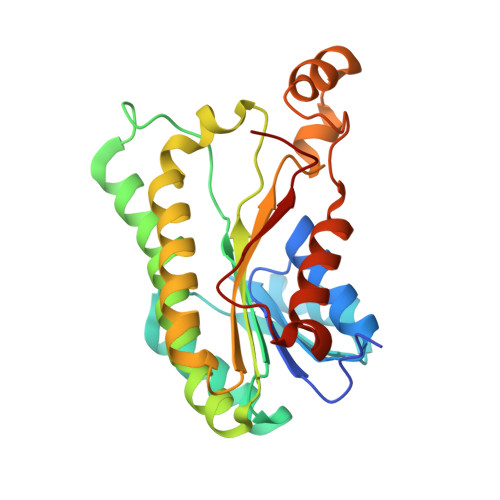Dissecting the Structural Elements for the Activation of beta-Ketoacyl-(Acyl Carrier Protein) Reductase from Vibrio cholerae.
Hou, J., Zheng, H., Chruszcz, M., Zimmerman, M.D., Shumilin, I.A., Osinski, T., Demas, M., Grimshaw, S., Minor, W.(2015) J Bacteriol 198: 463-476
- PubMed: 26553852
- DOI: https://doi.org/10.1128/JB.00360-15
- Primary Citation of Related Structures:
3OP4, 3RRO, 3RSH, 3TZC, 3TZK, 3U09, 4I08, 4WJZ, 4WK6, 5END - PubMed Abstract:
β-Ketoacyl-(acyl carrier protein) reductase (FabG) catalyzes the key reductive reaction in the elongation cycle of fatty acid synthesis (FAS), which is a vital metabolic pathway in bacteria and a promising target for new antibiotic development. The activation of the enzyme is usually linked to the formation of a catalytic triad and cofactor binding, and crystal structures of FabG from different organisms have been captured in either the active or inactive conformation. However, the structural elements which enable activation of FabG require further exploration. Here we report the findings of structural, enzymatic, and binding studies of the FabG protein found in the causative agent of cholera, Vibrio cholerae (vcFabG). vcFabG exists predominantly as a dimer in solution and is able to self-associate to form tetramers, which is the state seen in the crystal structure. The formation of the tetramer may be promoted by the presence of the cofactor NADP(H). The transition between the dimeric and tetrameric states of vcFabG is related to changes in the conformations of the α4/α5 helices on the dimer-dimer interface. Two glycine residues adjacent to the dimer interface (G92 and G141) are identified to be the hinge for the conformational changes, while the catalytic tyrosine (Y155) and a glutamine residue that forms hydrogen bonds to both loop β4-α4 and loop β5-α5 (Q152) stabilize the active conformation. The functions of the aforementioned residues were confirmed by binding and enzymatic assays for the corresponding mutants. This paper describes the results of structural, enzymatic, and binding studies of FabG from Vibrio cholerae (vcFabG). In this work, we dissected the structural elements responsible for the activation of vcFabG. The structural information provided here is essential for the development of antibiotics specifically targeting bacterial FabG, especially for the multidrug-resistant strains of V. cholerae.
- Department of Molecular Physiology and Biological Physics, University of Virginia, Charlottesville, Virginia, USA Center for Structural Genomics of Infectious Diseases (CSGID)‡
Organizational Affiliation:


















